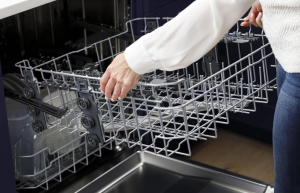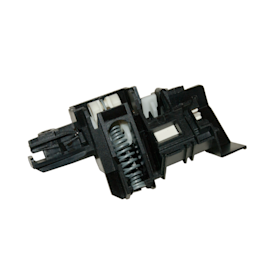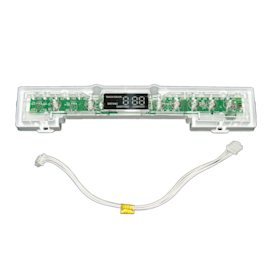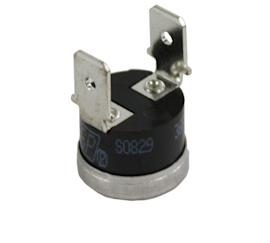What are the main parts of a dishwasher?


Dishwashers come a wide variety of brands and models, but they virtually all have the same main parts. Some basic dishwasher parts need little explanation. The dishwasher door hinges open to allow you load and unload the dishwasher. Dishracks hold the dishes in place during the dishwashing cycle.
Key components inside the dishwasher perform specific functions such as filling, spraying dishes and draining water. When a part fails, you’ll find dirty dishes or a tub still filled with water after the cycle ends.
Knowing some details about each main dishwasher part can help you troubleshoot problems when they occur so you can determine which part needs replacing.
What are the main parts of a dishwasher door?
Door latch assembly
The door latch assembly is mounted at the top of the dishwasher door. It has a catch that engages the strike when the door is closed so that it won't open during the dishwashing cycle. A handle mechanism on the latch assembly, or switch assembly, allows the catch to release the door strike so the door can be opened after the cycle is finished, or during the cycle if necessary.
This assembly includes the microswitches that are used to detect whether the dishwasher door is shut and latched properly. The dishwasher won't start unless the control detects that the door is properly closed.
Electronic control
The electronic control is the "brains" or motherboard of the dishwasher; it starts and stops all the dishwasher's functions—filling, washing, drying and draining. It receives a signal from the control panel when you select a button and displays the cycle status, time and other information on the control panel.
Thermal fuse
The thermal fuse is a safety device mounted on the electronic control board housing of the dishwasher that trips or blows when it experiences excessive current or when it overheats. A short in a component or wiring causes the thermal fuse to trip.
Control panel
The control panel (also called the control console) is mounted at the top of the dishwasher door and houses the selection buttons and the display for the dishwasher. The control panel connects to the electronic control board through a ribbon wire cable that communicates button presses and display functions.
Detergent dispenser
The detergent dispenser is mounted on the inner door panel and houses the dishwasher detergent in a covered compartment. The cover of the dishwasher dispenser has a latch mechanism controlled by the electronic control. The latch is released to open the cover and dispense the dishwasher detergent at the proper time during the dishwashing cycle. The dispenser also has a reservoir for the rinse aid. A small amount of rinse aid is dispensed from the reservoir during the final rinse portion of the dishwashing cycle.
Door hinge
The door hinge is mounted on the bottom of the dishwasher door. It pivots on the bottom of the dishwasher frame to allow the dishwasher door to open. The hinge has an arm that extends toward the rear of the dishwasher. A tension spring attached to that arm controls how fast the door drops when opened.
Door hinge spring
The hinge spring applies tension to the dishwasher door through the door hinge to prevent the dishwasher door from dropping too quickly when the dishwasher door is opened. One end of the spring is usually attached to the door hinge and the other end to the frame of the dishwasher. Each side of the dishwasher door has a spring.
Door balance link kit
The door balance link kit is a cord with connectors, where one end connects to the dishwasher door hinge and the other end connects to the tension spring on the frame of the dishwasher. The cord is routed through a balance guide component to properly align the cord for smooth movement as the dishwasher door is opened and closed.
Door seal
The door seal, or a door gasket, seals the gap between the opening to the dishwasher tub and the outer edge of the dishwasher door.
Vent and fan assembly
Located at the top of the door, the vent opens during the drying cycle so the fan can direct hot, moist air out of the dishwasher through the vent opening at the bottom of the dishwasher door. If the vent fails, the dishes won't dry as well because the steamy air stays inside the dishwasher tub.
If the fan fails, the control panel goes blank and the dishwasher stops in the middle of the cycle. Replace the vent and fan assembly if either the vent or fan fails.
What are the main parts inside the dishwasher tub?
Spray arms
Many dishwashers have two rotating wash arms that distribute spray throughout the tub. One spray arm is attached to the top of the circulation pump at the bottom of the tub. The other spray arm is typically attached to the underside of the upper dishrack.
Holes in the spray arms can get clogged with debris and hard water deposits. Dishes won’t get clean when spray arm holes get clogged. Clean deposits and debris from spray arm holes periodically using bamboo skewers.
Replace a spray arm if it gets cracked or damaged.
Heating element
The heating element is mounted on the bottom of the dishwasher tub and is responsible for heating the water during the wash and rinse portions of the cycle. Raising the water temperature improves cleaning, and in some situations, sanitation. The heating element is controlled by the timer or electronic control board in the console.
The heating element also heats the air inside the tub in the drying portion of the cycle. If dishes are still wet after the cycle ends, you may need to replace the heating element.
Overfill float switch
The overfill float switch is connected to the overflow float. The overfill float, or mushroom float, rises as the water level in the dishwasher rises during the fill process. If the water rises to the maximum height, a shaft on the bottom of the float activates the overfill float switch, which cuts off the voltage supply to the solenoid water fill valve so that the dishwasher stops filling.
If an item such as a piece of silverware gets stuck under the overfill float and the float sticks in the raised position, the dishwasher won’t fill. If the dishwasher starts but doesn’t fill with water, check for an item underneath the overfill float. Remove the item and the dishwasher may begin filling.
Removable filter
Located in the bottom of the tub, the removable filter traps broken glass and other large debris as spray water flows down into the sump and gets pumped back up through the spray arms. Clean the removable filter regularly so the dishwasher can clean and rinse dishes effectively during the cycle.
What are the main parts underneath the dishwasher tub?
Circulation pump
The circulation pump motor spins the impeller of the circulation pump to move water up through the spray arms during the wash and rinse portions of the dishwashing cycle. Water drops down through the filter system and into the sump. The pump then circulates the water back through the spray arms to clean and rinse dishes.
Diverter motor
The diverter motor moves the diverter disc into position so the disc can direct water through the upper spray arms. The diverter motor also sends a signal to the electronic control board about the disc’s position. If the diverter motor fails, the dishwasher stops and signals an error code (check out our dishwasher error codes for many brands). Replace the diverter motor if the error code indicates the diverter motor failed.
Water inlet valve
A water inlet valve is an electrically operated solenoid water valve that controls the flow of water into the dishwasher during the fill process. Solenoid coils on the valve cause it to open when the timer or electronic control board triggers the valve. When no voltage is applied to the solenoid coil, the valve remains shut and no water flows into the dishwasher tub from the water inlet supply line.
Drain pump
The drain pump removes the water from the dishwasher tub during the drain portion of the wash and rinse cycles.
Drain line
A drain line, or drain hose, is a hose that carries the drain water from the drain pump to the sink drain.
Check valve
The check valve is a component in the outlet water path of the drain system that allows water to drain from the dishwasher and prevents it from flowing back into the tub. It consists of a flexible piece of plastic or rubber that bends in one direction. The flapper seals against a lip in the outlet water hose. It can be positioned inside the sump or just outside the sump in the drain system path. It also can be positioned on the outlet tube of the drain pump.
High-limit thermostat
The high-limit thermostat at the bottom of the dishwasher tub shuts off the heating element when it detects water temperature above 207 degrees Fahrenheit. A defective high-limit thermostat trips at a cooler temperature, preventing the heating element from heating. You can check for electrical continuity through the high-limit thermostat using a multimeter. If you measure no continuity at room temperature, the high-limit thermostat tripped at room temperature and is defective. Replace the high-limit thermostat if it’s defective.
How do I troubleshoot dishwasher problems?
Knowing about the different parts of a dishwasher can help you understand which part needs replacing when your dishwasher acts up. You’ll also need to use troubleshooting tactics and testing to accurately figure out which part to replace.
Why won’t my dishwasher power up?
When your dishwasher won’t power up, follow the troubleshooting steps in this video to find and fix the cause of the problem:
That video shows you that fixing a dead dishwasher can be as easy as turning on a light switch. The video begins with basic troubleshooting and progresses through more advanced diagnosis techniques. If you get to a point where you’re not confident that you can perform some of the more advanced troubleshooting, schedule a service technician to diagnose and repair your dishwasher.
How do I troubleshoot other dishwasher problems?
We have helpful videos to guide you in troubleshooting other common dishwasher failures.
Follow the steps in these videos to fix common dishwasher problems:
You can find more DIY repair help for dishwashers and other appliances in the Repair Help section of our Sears PartsDirect website. Our repair help includes DIY troubleshooting tips as well as videos that show how to replace common parts in appliances.
When you encounter a repair that’s beyond your capabilities to fix on your own, rely on our Sears Technicians to diagnose and repair your appliances.
Most common symptoms to help you fix your dishwashers
Choose a symptom to see related dishwasher repairs.
Main causes: broken door spring, damaged or broken door hinge…
Main causes: damaged or stuck spray arm, leaking door seal, damaged door hinge, leaky heating element water seal, cracke…
Main causes: broken door latch, tripped circuit breaker, broken heating element, faulty vent fan, sensor failure, contro…
Main causes: improper loading, low water temperature, improper detergent dosage, detergent dispenser failure, spray arm …
Main causes: clogged kitchen sink drain, clogged drain hose, drain check valve damaged, drain pump failure, control syst…
Main cause: damaged rack height adjuster…
Main causes: glass or popcorn kernel stuck in the chopper blade, drain line vibrating against the cabinet, debris in was…
Main causes: not using rinse aid, rinse aid dispenser failure, broken heating element, malfunctioning vent, drying fan f…
Main causes: light switch beside the sink turned off, lack of power, bad dishwasher door switch, control system failure,…
Most common repair guides to help fix your dishwashers
These step-by-step repair guides will help you safely fix what’s broken on your dishwasher.

How to replace a dishwasher door latch assembly
If the dishwasher door doesn't click shut, a broken door latch is a likely cause. Follow these instructions to replace i…

How to replace a dishwasher user interface control
The user interface control houses the selection buttons and display. If it fails, you can't select the cycle and setting…

How to replace a dishwasher thermal fuse
A completely dead control panel often indicates that the thermal fuse on the electronic control board is blown; follow t…
Effective articles & videos to help repair your dishwashers
Use the advice and tips in these articles and videos to get the most out of your dishwasher.

Get tips on completing essential holiday cleaning tasks to brighten your home.…

Learn about all the convenient features on our Sears PartsDirect website that make your parts purchases easier.…

Get answers to frequently asked questions about Sears and Sears PartsDirect.…
